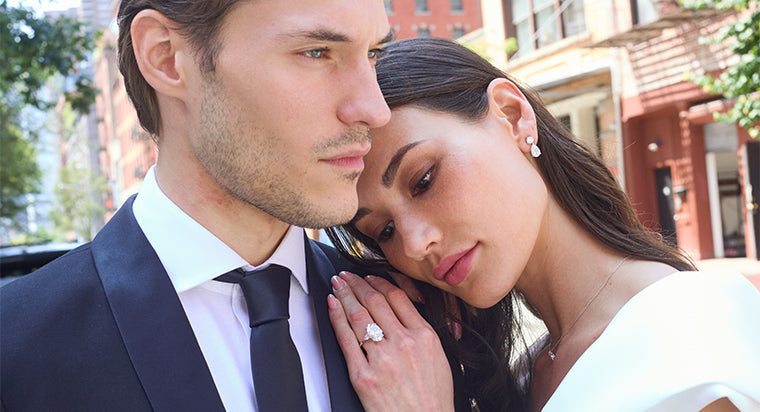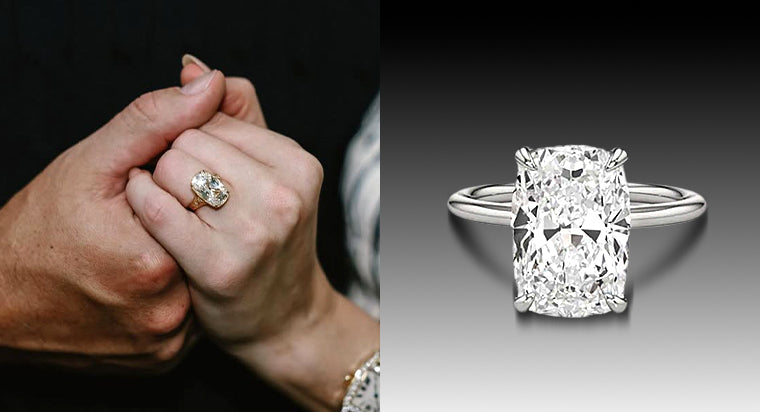The Ultimate Guide to GIA Diamonds: What You Need to Know When Shopping for an Engagement Ring

Engagement rings are incredibly sentimental. For many, they're one of the most significant diamond jewelry pieces they'll ever own. Rings are frequently handed down through families as heirloom pieces, making choosing the right diamond much more important.
You don't need to spend a fortune on a gem, but you also don't want to select one based on appearance alone. Specific characteristics can add or detract value from a diamond; knowing them helps you make an informed choice. The Gemological Institute of America (GIA) strives to aid consumers with picking the perfect stone by putting forth a set of standards that each diamond is graded against. Understanding the "how" and "why" of the GIA can help you choose the best diamond for your ring.
Table of Contents
What is GIA?
The Gemological Institute of America, commonly known as the GIA, is a nonprofit institute focused on research and the education of consumers concerning the field of gemology and jewelry arts." As an institute, they test and evaluate diamonds to create a report. The report breaks down various characteristics of the diamond, informing buyers of how valuable the diamond is.
Once a stone has this assessment, it is often referred to as a GIA diamond, meaning it has undergone a GIA assessment. GIA can be trusted to provide an accurate evaluation as an independent office that doesn't mine, buy, or sell diamonds. How do they get their stones? Jewelers and even individual consumers submit their diamonds to the institute for grading. Not all diamonds are GIA diamonds, though almost every reputable jeweler often only has a selection of GIA stones (and there are a lot!). It's important to note, though, that there really isn't anything like a GIA "certified" diamond as the laboratory doesn't certify stones, only assess them and create a report.
Nevertheless, having a GIA report with your stone is an excellent way to verify its authenticity and value.
The 4Cs of Diamond Grading
The GIA grades diamonds based on the4 C's – carat, cut, color, and clarity. Its evaluation is much more rigorous than most standard jewelers, truly investigating the extent of each characteristic and measuring how it measures up against other stones.
Carat weight
Carat weight refers to the diamond's "size" even though it isn't an exact measure of its dimensions. Using an electronic micro-balance, they can find the carat weight to the nearest ten-thousandth of a carat. Then, they can use optical measuring devices to denote its measurements, proportions, and the angles of its facets.
Cut
The cut is assessed by measuring how well the cuts, angles, proportions, and facets enhance the diamond's appearance, considering fire, brilliance, and scintillation. Unfortunately, the GIA can't provide a cut grade for fancy diamonds, only round brilliant stones in the D-to-Z color range.
Color
Speaking of color range, the GIA relies on a standardized viewing environment to check the color of the diamond, comparing it to the most pristine examples in each color category. Many color graders give their opinion and must come to a consensus before a color grade is applied, ranging from D (the most colorless) to Z (a yellow or brown color).
Clarity
Natural diamonds can have issues within the stone, called inclusions, or defects on their surface, known as blemishes. Using 10x magnification, the GIA can easily spot these problems and determine how they affect the clarity of the diamond. Poor clarity can make a diamond appear dull by altering its brilliance, scintillation, and fire. Diamonds are rated in terms of clarity from "Flawless (F)" to "Included 3 (I3)."
GIA Diamond Grading Report
Once the GIA reviews your diamond's characteristics, they'll issue a report. It includes an accurate and complete description of the stone, highlighting any issues or problems the graders found. They can be a bit scientific, but thankfully, the GIA includes a video tutorial on reading and understanding your assessment. In addition, your jeweler should be able to discuss the report with you and answer any questions you may have.
GIA Diamond Certification
You'll often see the term "GIA certified" in reference to diamonds; even the best jewelers will use it. In truth, it's a bit of a misnomer because GIA doesn't actually "certify" diamonds; it only grades them. Nevertheless, the title can be a clear indicator to consumers that the stone has been formally assessed at a GIA lab.
Having a GIA report is essential because it helps authenticate your stone's quality and value. You don't have to take anyone's word that your diamond is flawless or a D color; the report will tell you the truth. The institute even has a website that lets you check the report's legitimacy, called the GIA report check website, where you can view a digital version of the paper certification.
Diamond Price and Value
Why do you need a report? Because all of the factors in GIA grades significantly affect a diamond's price. It's a misconception that the cost of a stone is based exclusively on carat weight. A large diamond with poor cut, clarity, and color, costs just as much as a small diamond with excellent cut, color, and clarity. These things combine to determine a diamond's price and value.
In addition, a few features beyond the 4 C's can affect value, such as the diamond shape. Some shapes, like round brilliant, are more popular than others, and their price will reflect this demand. Of course, the materials you set your diamond in affect your engagement ring's overall price and value. Therefore, it's important to consider all of these factors against your budget when shopping for a diamond. You don't need the highest grade of cut, color, clarity, or the biggest stone. Instead, choose a diamond with an appearance you're pleased with that doesn't break the bank.
Additional Considerations
The GIA report isn't the only paperwork you need when diamond shopping. Also, ask for the jeweler's warranties, return policies, and insurance options. Many establishments offer GIA diamonds, but not all will assist you with a return or upgrade or offer regular inspections and cleaning.
A reputable jeweler like With Clarity can assist you with your diamond engagement ring from selection to post-proposal care and follow-up, helping you celebrate life's most memorable moments with confidence and care.
FAQs
What services does GIA offer apart from diamond grading and certification?
The GIA will evaluate all gemstones, not just diamonds. They also provide lots of educational materials and research that can benefit gem buyers and sellers.
How can I verify the legitimacy of a GIA certification?
The GIA offers a website that you can visit to check the legitimacy of your report by viewing the digital version and comparing it to your paper copy.
Does a GIA-certified diamond cost more than a non-graded diamond?
Sometimes a GIA-certified diamond can cost more than a non-graded diamond only because GIA-certified stones are usually of higher quality, making them a truly valuable gem whose worth won't decrease over time.
Is a GIA diamond better than a regular diamond?
A GIA diamond isn't necessarily better, but it does ensure the authenticity of your stone's quality and value, often making it a safer choice for buyers.









